The AHS Blog

Job done!
This post was written by Matthew Read
Public clocks that don’t work; there are thousands of them. An irritation, sign of the neglectful and difficult times or simply a reflection of the lack of need for the dissemination of time in that format? Big questions but in this case a relatively simple solution with interesting conservation issues thrown in.
The plan to reinstate the long-dilapidated village hall clock with a modern equivalent. Easy reliable low maintenance solution? But what actually happened to the earlier clock? Did it still exist? Could it be reinstated? Questions sometimes make things more complicated but in this instance, the result was felt to justify the extra energy.
The re-discovered clock was probably originally installed in the 1930’s; Smith mains synchronous movement with hand setting by leaning out of the window to reach the adjusting knob. Although potentially perfectly serviceable, due to the mains voltage and window leaning out of combination , it was decided to replace the movement with a low-voltage slave, controlled from inside the building (the original movement packaged within the clock case.
The painted aluminium dial had discoloured with parked hands and some corrosion. Repainting the dial would have obliterated the original/existing surface so a decision made to copy the dial on the reverse, thus preserving what existed and the dial was turned inside-out.
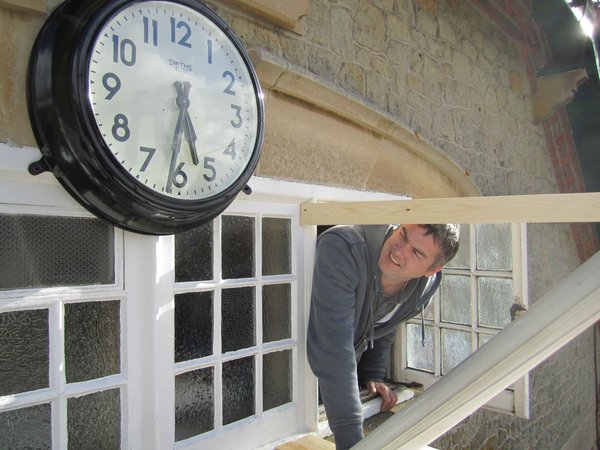
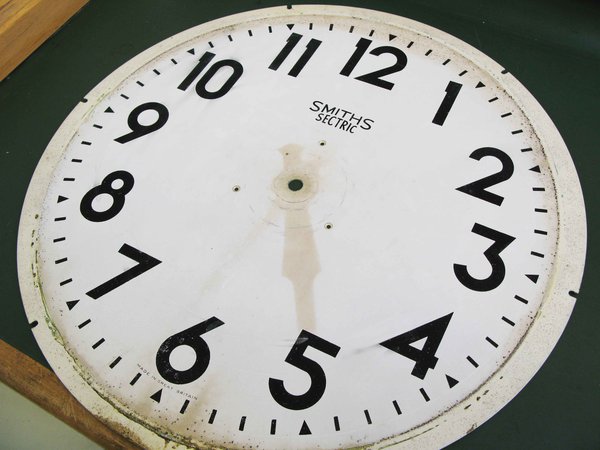
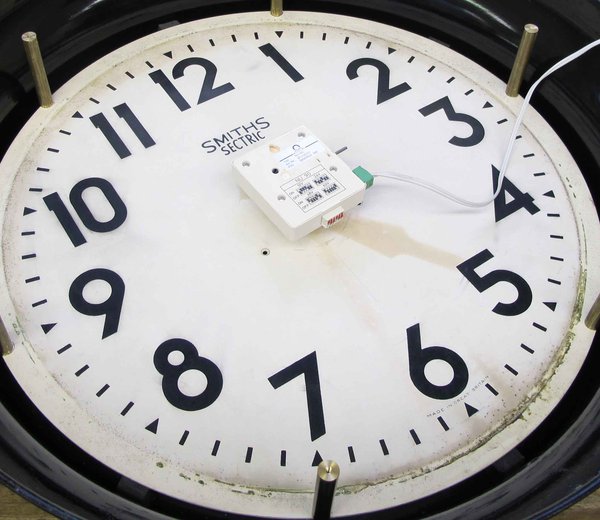
Happy villagers, public time restored, happy conservation compromise, job done.
The Empire Hall was built in 1907 for the village by James Buchanan (later Lord Woolavington) of Lavington Park.
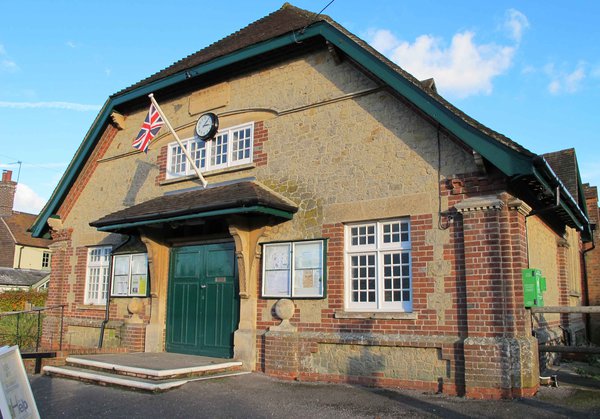
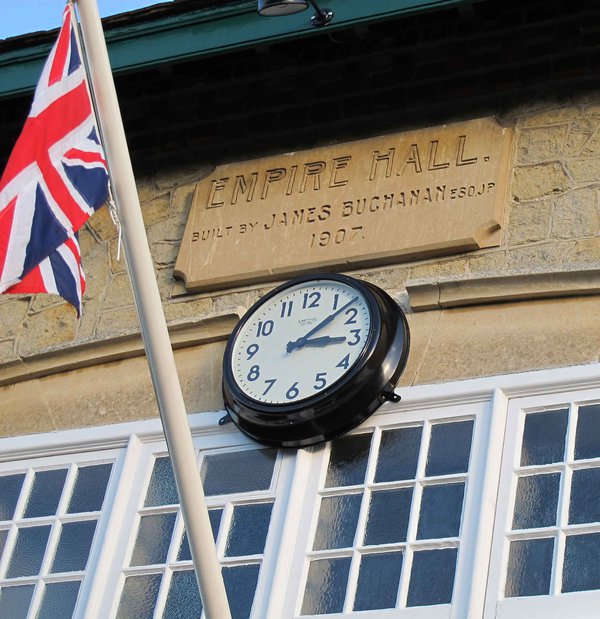
Time on the BBC
This post was written by David Rooney
A couple of weeks ago, BBC radio listeners around the world celebrated the 90th anniversary of the corporation’s founding as the British Broadcasting Company.
On 14 November, a special edition of Simon Mayo’s Drive Time show was broadcast live from the Science Museum, London, in front of the first BBC transmitter, known as ‘2LO’. It’s on show as part of a free temporary exhibit.
Radio broadcasting changed the face of timekeeping. When the BBC was founded in 1922, wireless time signals had been around for about a decade, transmitted from the Eiffel Tower, but they were for specialists, not the public. The BBC brought accurate Greenwich time into the living rooms of the nation.
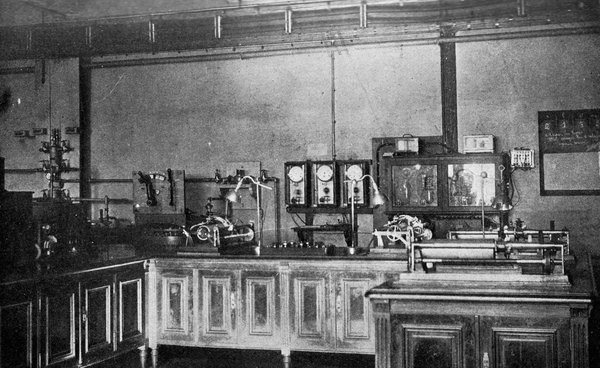
The first BBC time signals came from the announcers reading out the time. Within a year, a special set of tubular bells was in use, sounding time by the Westminster chimes. But in 1924, the now-familiar ‘six pip’ time signal began. And it’s still in use today – although listeners on digital radio hear the signal a couple of seconds late. Progress, I guess.
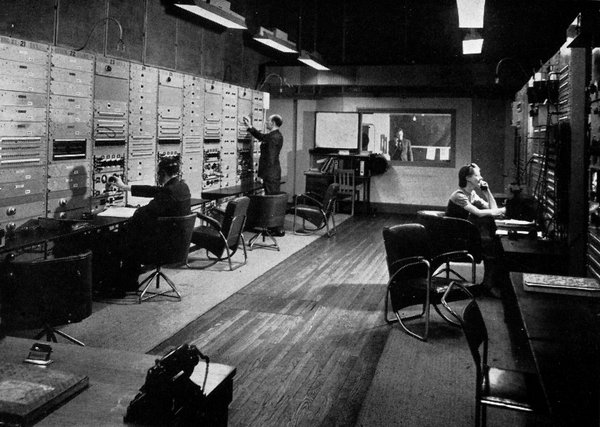
But the six pips wasn’t the only time signal set up by the BBC in its earliest years. The familiar sound of Big Ben was also captured live by BBC microphones from 1923 – and that system too is still in place.

It’s time, I’m afraid, for the inevitable plug: to find out more about time signals on the BBC, try my book, Ruth Belville: The Greenwich Time Lady. In it, you can discover why Dame Nellie Melba had reason to say, ‘young man, if you think I am going to climb up there, you are greatly mistaken!’
Happy birthday, BBC…
A pointless exercise
This post was written by David Thompson
Sometimes, ideas were way ahead of their time and when they were first thought up they had no application. Subsequently, however, the concept became a popular and widely used one.

Today with frequent and easy air travel, as well as instant communication around the world, the appearance of a world time dial on a watch makes perfect sense and indeed such dials are common. A simple Google search for ‘World Time Watch’ brings up over 2 million references.
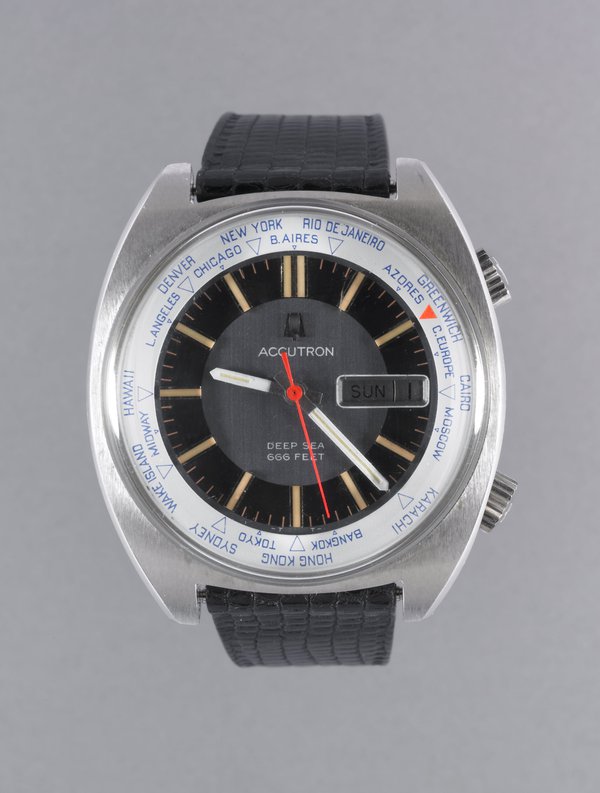
What use would such a watch be in the second half of the 18th century.
Imagine a man-about-town in London showing off his latest purchase to his friends and being proud of the fact that he could tell them what time it was on other parts of the globe. When any communication with such places would have taken months at least, you can just hear his friends saying,‘fascinating, but what’s the point – and where is Antiqua anyway?
Nevertheless such watches did exist in the mid-18th century and one example survives to this day in the British Museum Collections.
It is a gold pair-cased watch made by John Neale in London in 1770. It shows the time in London, Mexico, Persia, Antegoa, Russia, Italy, China and other exotic places. It was probably sold as a gimmick, as something out of the ordinary and a curiosity which didn’t need to have a purpose – just a bit of fun for the owner who could say ‘did you know………….?
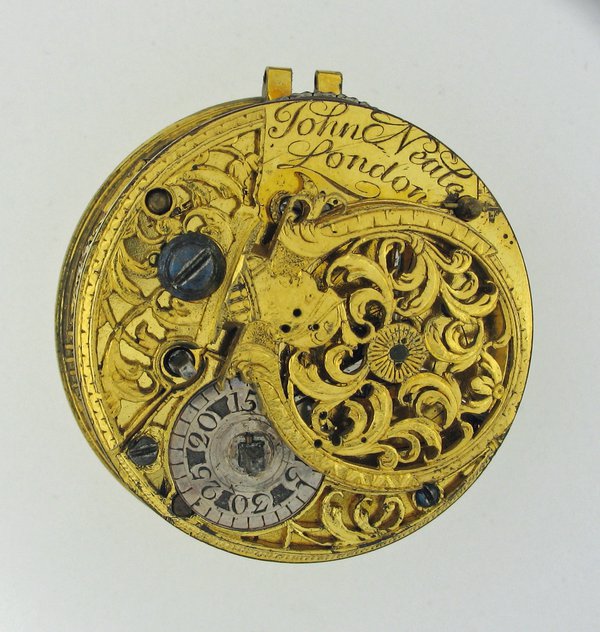

A eureka moment of recognition
This post was written by James Nye
Sometimes, every once in a while, one’s record-keeping comes up trumps. Rooney and I wrote up the history of the Standard Time Company in Antiquarian Horology back in 2007, and widened our scope in the BJHS.
Since then, very little further factual detail has come to light. Certainly there has been a dearth of newly found objects badged STC – which is a shame. We had hoped our piece would bring to light more clocks and ephemera.
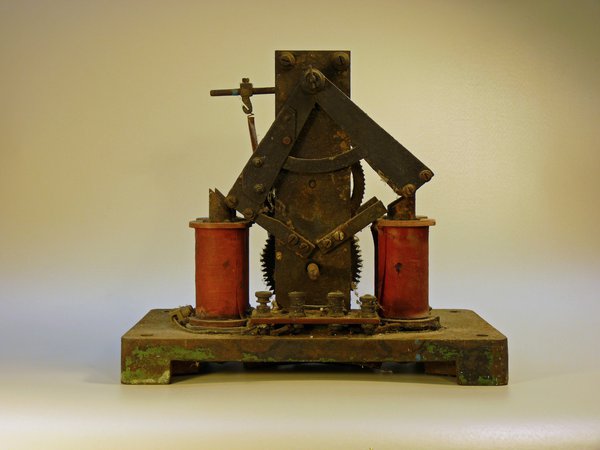
Keith Scobie-Youngs of the Cumbria Clock Company unearthed an unusual tower slave last year, which a couple of us thought might well be from STC, but we lacked any evidence. It is of very distinctive form and bears no signature, or if there is one it is beneath layers of typical clock-tower grime. Despite no obvious identifying marks on the corpse, there was nevertheless buried deep in my memory a faint recollection of something of this form.
I didn’t spring naked from my bath and run around West Norwood, I admit, but I did just have that ‘Eureka’ moment, when I remembered having scanned a document that George Arthur, the authority on all matters related to Lowne clocks and instruments, had shown me, years ago.
In the 1920s, there was a period when Joseph William Molden, an Australian entrepreneur, had built a small electric clock empire, which brought together STC and Lowne for a time.

In the Lowne archive there is a picture, very faded, of precisely the device in question, mocked up with leading off work, sitting atop a leather stool. A typewritten description attached to the picture led me to the Horological Journal of 1920, and there, bold as brass, was our movement, titled ‘New Patent Electric Impulse Movement’.
Click here to see the patent. In conclusion, a neat tie-up between original documents and a recovered object. Too bad we still cannot locate one of the master clocks used to drive it, but we live in hope.
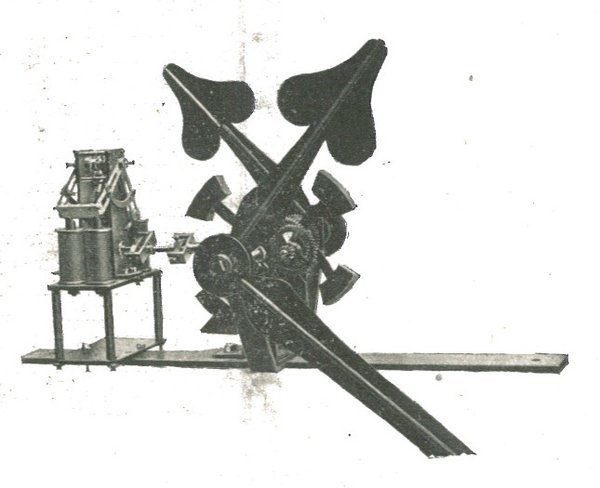
Anyone for Venice?
This post was written by James Nye
Rome may be the ‘eternal city’ but for La Serenissima – Venice – time also stands still, or at least it has for me over four decades of visiting the city, with various familiar walks reviving favourite memories at each corner turned.
Something I have noticed for the last thirty years or so is a series of public clocks in the campos and calles – not galley slaves, but alley slaves. These are minute-impulse devices, mostly with a single dial, but a few double-dialled versions on street corners. They have a fairly classic or traditional feel to them, with opalescent dials that are back-lit at night, and cast cherubic and heraldic detailing to the metal cases.
I have never succeeded in tracking down anyone I could ask about their origins or date – if anyone can help, please do let me know. There might be twenty or thirty dotted across the city, and while some are in obvious positions, a few present themselves in seemingly quiet and untravelled quarters, perhaps reflecting changing patterns of street usage.
The cases, dials and hands are survivors of an original installation – on asking among expert friends one commented the pattern is one that could have been used by any one of many different electric clock firms – we would only know which if we could see inside, and I didn’t have a ladder on me this time. No doubt the original central master-clock and city-wide wiring has all long disappeared.
On a visual inspection I would judge each clock now to be independently driven by a local, radio-controlled, electronic master clock, thus giving precise time, corrected automatically for daylight saving. The Venetian authorities have therefore understood (unusually among their peers) that the impulse-clocks themselves can easily be made to last for generations – it is the network that supplies the impulses which may need updating – a message I bang on about frequently, as friends will know.
Venice – a timeless city – moving with the times.
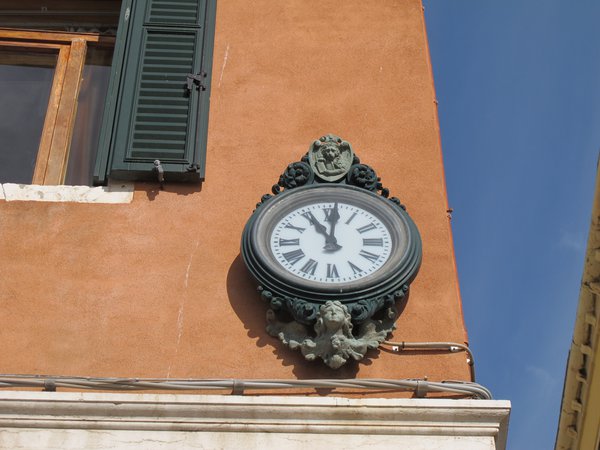
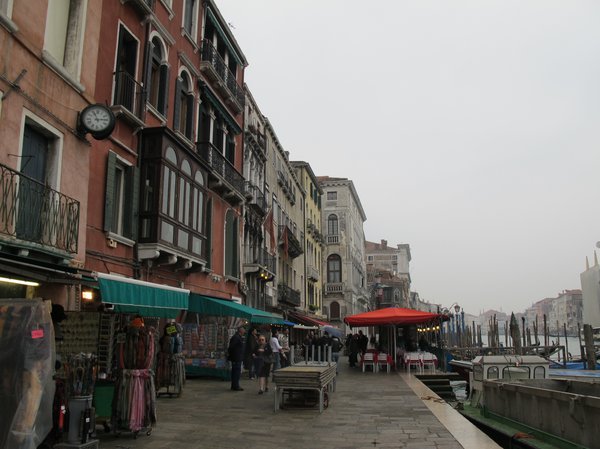

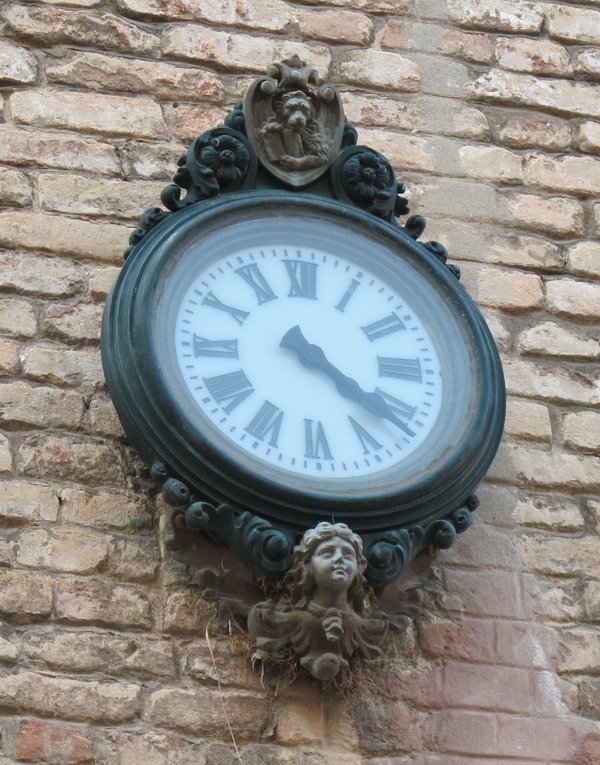
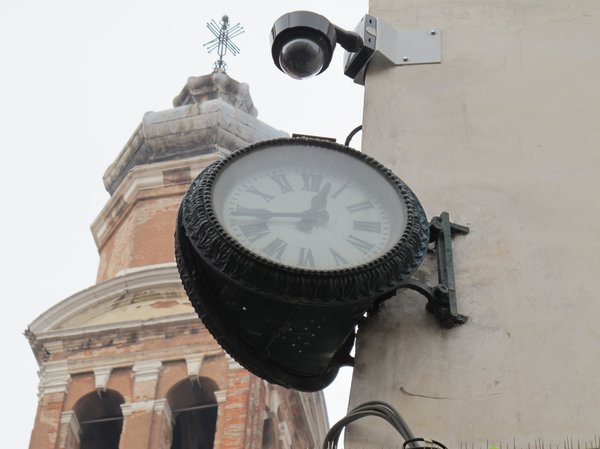
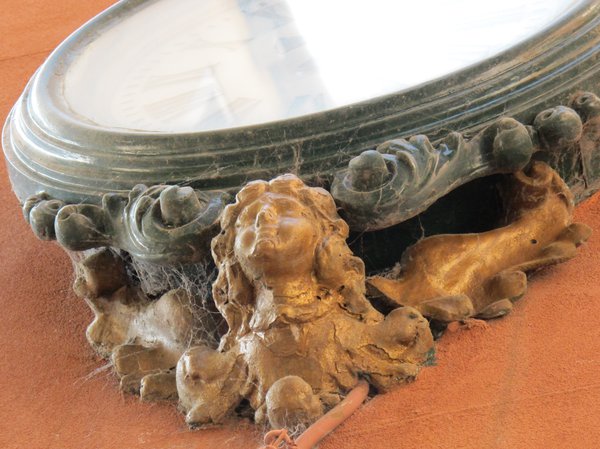

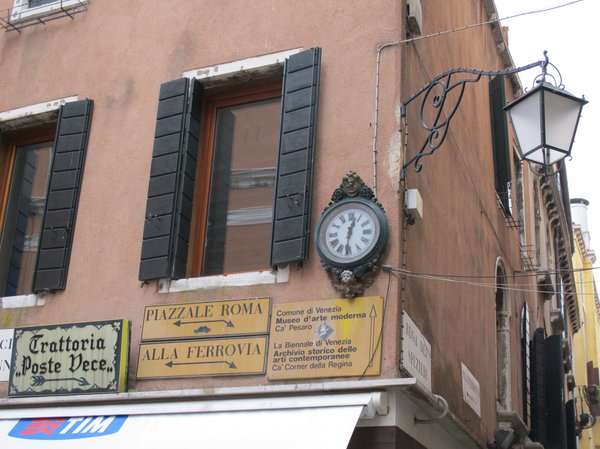
Letters on the dial
This post was written by Peter de Clercq
We are so used to telling the time from dials that we don’t really need the hour numerals. Some dial designs omit them altogether – distinctly uncluttered but also perhaps a bit dull. There is an alternative, which I find more fun.
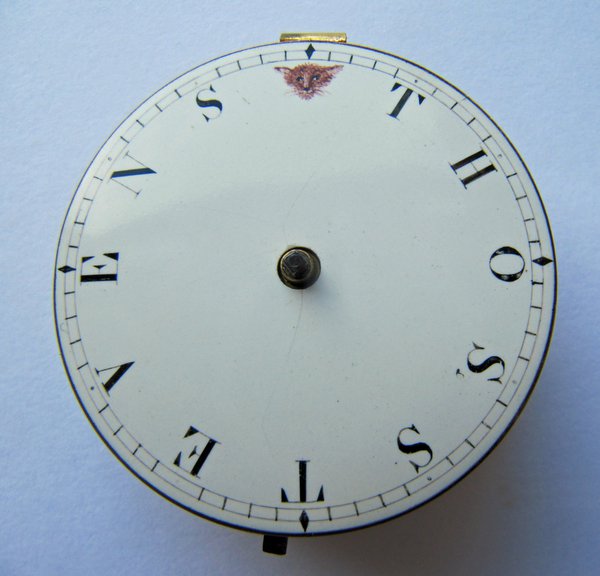
Watches can be personalized by substituting the letters of the owner’s name for the hour numerals. As Cedric Jagger writes in his book The Artistry of the English Watch , this was by no means uncommon.
If the name did not have exactly twelve letters, the designer had to be inventive, as the three watch photos here demonstrate. The one with JAMES CATLING, dated 1814, gave no problems, but for GEORGE CATLING, dated 1815, NG had to be linked. On the other hand, for the eleven-lettered THO[MA]S STEVENS, dated c. 1840, the designer used a fox’s head at 12 o’clock.
Was this randomly chosen or was the owner perhaps an avid fox hunter?


At least two English churches sport a lettered dial. The one on St Peter’s Church Buckland in the Moor, Dartmoor reads ‘My Dear Mother’, and was commissioned by the man who donated the clock along with three new bells in 1931. And during a recent trip in Norfolk, the AHS Turret Clock Group saw ‘Watch and Pray’ on the dial of the clock at All Saints Church in West Acre.
These are the first words from Matthew 26:41, where Jesus is addressing his disciples on the Mount of Olives just before his crucifixion: ‘Watch and pray, that ye enter not into temptation: the spirit indeed is willing, but the flesh is weak’.
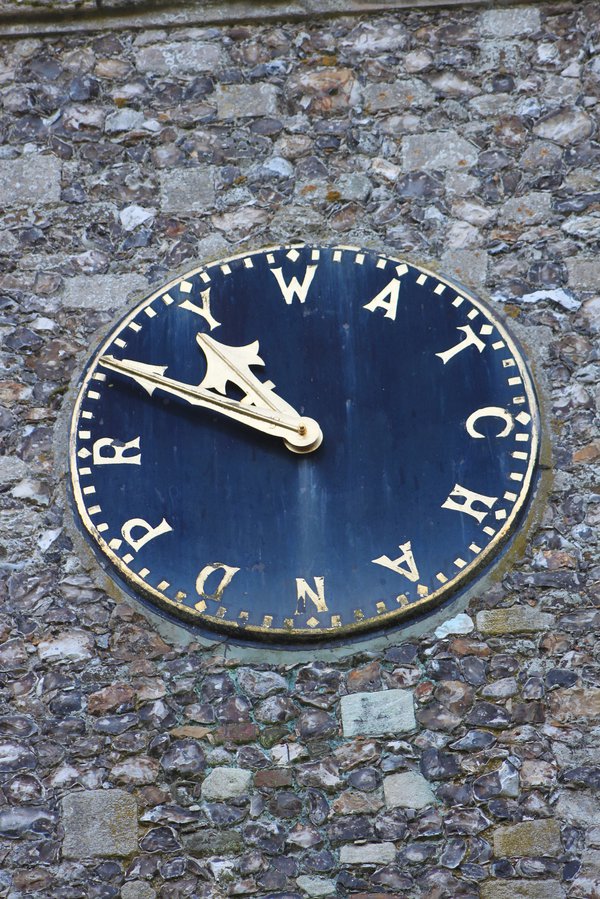
Finally, I was interested recently to come across this image of a mid-20th century electrical wall clock with special dial lettering and hands for the York Evening Press newspaper office, supplied by Telephone Rentals.
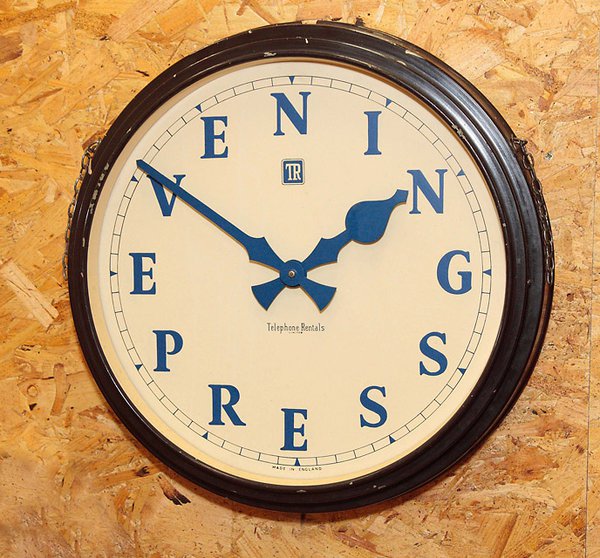
If you like this kind of thing, you may want to join a group of enthusiasts who share images and information online on just that: clocks and watches with letters. But on their database I do not see any longcase clocks with letters instead of numerals on the dial. So if you know of one, please leave a comment!
For use of their photos I thank three AHS members: Dave Stables (who published on the Catling watches in Antiquarian Horology of June 2011 and also online), turret clock specialist Chris McKay and the chairman of the AHS Electrical Horology Group, Martin Ridout.
Time by telephone kiosk
This post was written by David Rooney
A few weeks ago I wrote about telephone kiosks. Today I’m returning to that theme, because I’m fascinated by how many clocks are embedded in our daily lives, hidden in the everyday infrastructure surrounding us.

The nights are drawing in. We’ve reset the clocks back to GMT for another year, and many of us start travelling to and from work in the dark. Thanks goodness for street lights – and for the time switches that turn them on and off every day. Countless clocks hidden inside countless lampposts.
But, every so often, hidden technologies reveal themselves, either by accident or design. In 1931, Britain’s watch and clock makers were told about a new way to find the time when out on the street.
'The latest type of Venner Time Switches installed in the G.P.O. telephone kiosks have a glass window over the dial. The purpose is to enable their timekeeping to be more easily checked, but in addition, the device will be useful to the public, for the time to the nearest five minutes can easily be seen.' The Watch and Clock Maker, 15 November 1931.
These time switches were used to operate the kiosk’s lamp, and they were pretty sophisticated.
Each one was a spring-driven mechanical clock, wound up every eight hours by an electric motor. In case the kiosk’s power supply failed, the time switch had enough power in its spring to operate the clock for three days. And every day the switching times were adjusted to track the rising and setting of the sun.
You can find out more from a 1934 article reproduced here. But could the time switches really be ‘easily’ seen, as the quotation states? Here’s a photograph of one of them in situ. I’ll leave you to decide…
Where on earth have you been?
This post was written by David Thompson
Sometimes watches have a particular association with a particular person and we know about from an inscription written somewhere on it.
This particular watch, by Samuel Toulmin of the Strand in London, made in 1775, has a finely engraved inscription on the back of the outer case, ‘Thos Justice Esq. Appleford Berks’. There was a Thomas Justice of Appleford who is described as having died of ‘intemperance’ in September 1789. Could he have been the first owner of the watch who had it inscribed on the back in 1775?
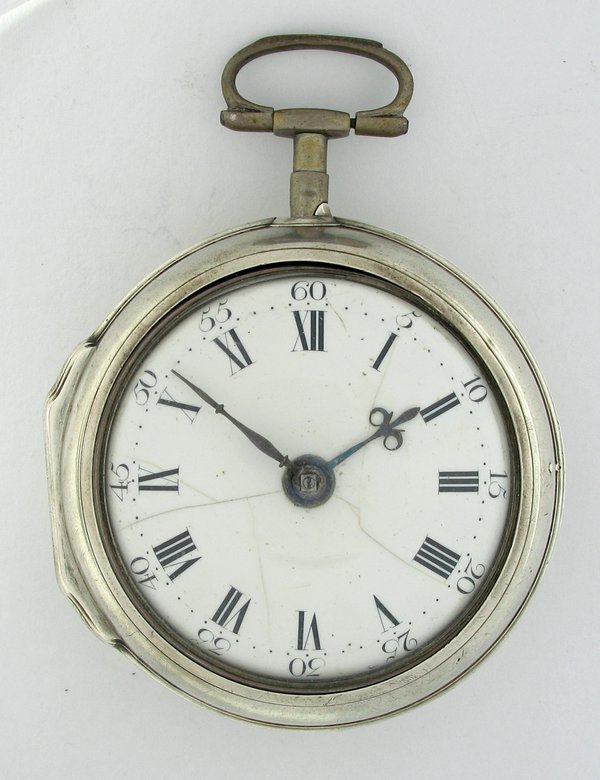
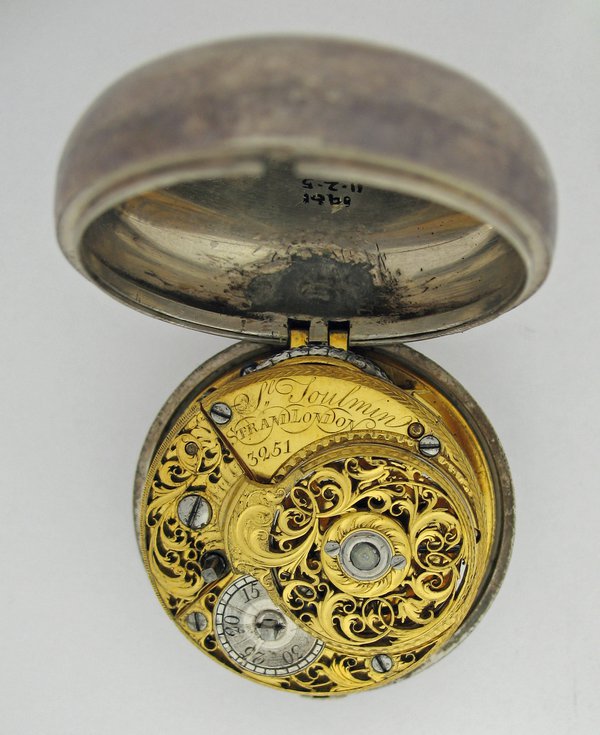
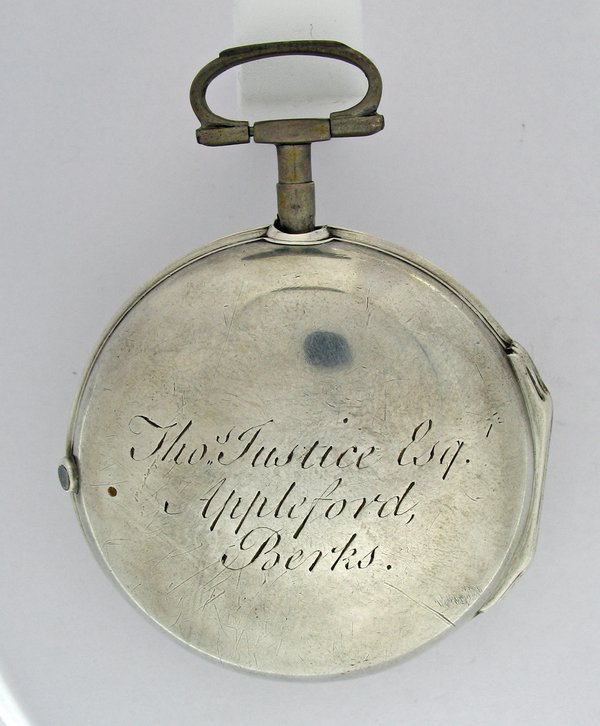
Further information about an owner of the watch appears on an advertising paper inside the case. The information on the paper tells us that by 1822 the watch was in Abbingdon, in Berkshire, where it was looked at by Thomas Ansell near the Abbey – presumably a routing clean and re-oil. We are fortunate that an inscription on the reverse of the paper reveals the name of its owner at that time as Mr. Thomas Justice, Appleford.
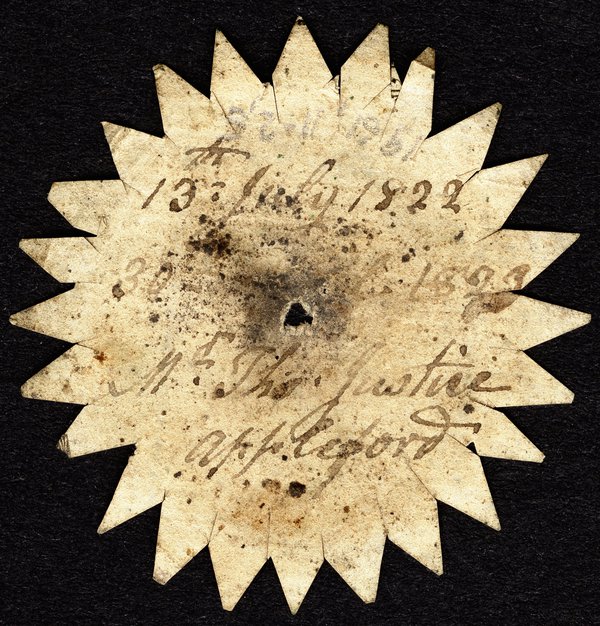

On Wednesday 20th January 1830, a group of properties in Appleford, Sutton Courtney, formerly owned or rented by Thomas Justice were auctioned at the Crown & Thistle in Abingdon. It may be that Thomas was trying to realise some cash. On Monday 8th February 1830 a petition was heard at court in Portugal Street, Lincolns Inn Fields, London, concerning the Insolvency of one Thomas Justice, late farmer of Appleford.
In the church of St. Peter & St. Paul in Appleford is the following memorial:-
'In a vault near this church lie interred the remains of Thomas Justice Esquire, late of this parish who departed this life on the fourth day of January 1843 aged 54. Also of Martha Justice reliat of the above who departed this life on the 8th day of September1848 aged 59. Also of Thomas Francis Justice, Esquire, son of the above. Who departed this life on the 13th day of January 1847 in the 28th year of his Age.'
There’s a lot more to say about the Justice family of Appleford but it’s amazing what can be found on the internet in a very short time.
As one journey ends another begins
This post was written by Matthew Read
It was with some sadness (weep!) that postgraduate and MA students Francoise Collanges and Brittany Cox recently fled, or rather graduated from the West Dean nest. Over the summer period they completed their practical MA projects and accompanying 12,000 word theses.
Both Francoise's work in the study of early electro-magnetic clocks and Brittany’s in the materials used inside automata that smoke (!) will undoubtedly add value to the body of knowledge in these specialist fields. During the process, a lot of fun, blood sweat and tears ensued. Result! We wish them both well.

Early October saw the intake of new students and the welcome back of those returning. All students new to the clocks programme at West Dean begin their long journey through horological bench craft skill by designing and making their very own clock.
As a beginning, clockmaking embraces so many of the materials, tools, techniques required for later life as conservator restorers. The world of turning, soldering, filing and scraping, geometry, mechanics and a little mathematics thrown in is a demanding one, and interestingly, the outcomes from what is outwardly a uniform process, are as diverse as the students themselves. Christmas should see trains and frames completed, entire clocks by awards day 2013.
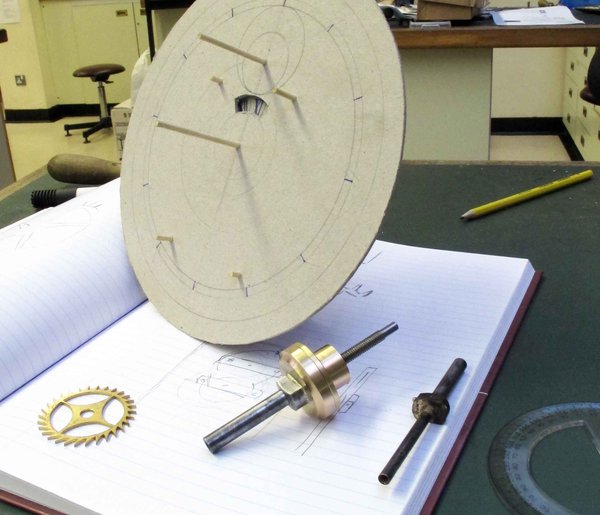
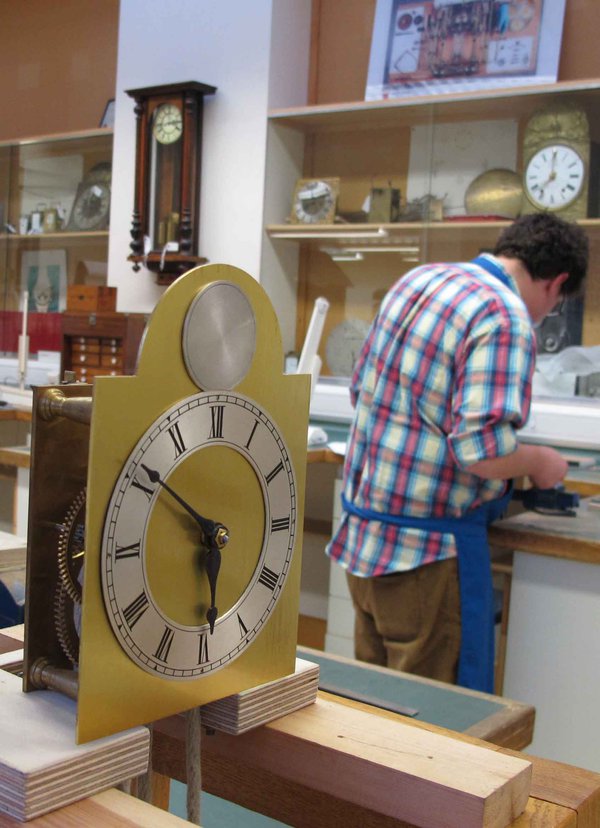
Returning students on Diploma and Postgraduate programmes are working on historic clock projects. These span sensitive cleaning and conservation of a mystery clock by Houdin, through the repair of an imposing ormolu mounted mantel clock signed Cellier, to the reinstatement of verge and crownwheel escapement to an early eighteenth century spring clock.
Many of the projects are multi-media and therefore require interdepartmental liaison in the conservation and repair processes. Never a dull day in clockmaking.
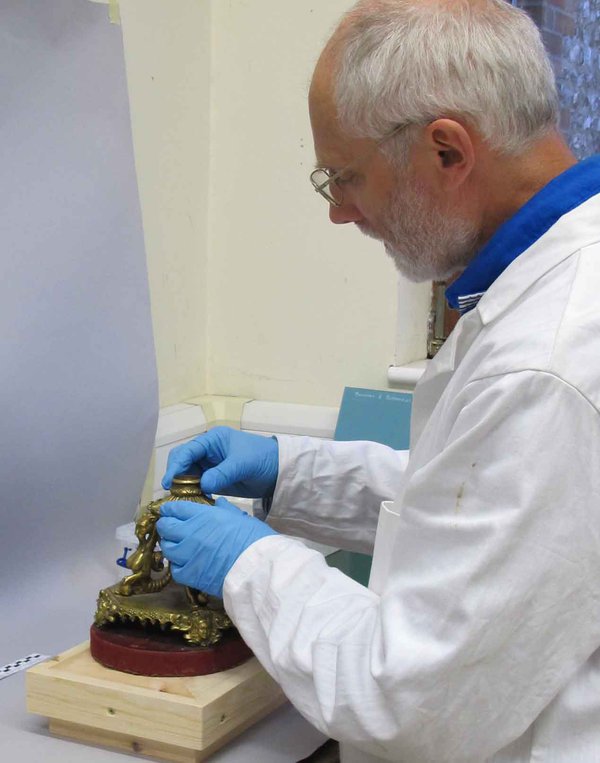
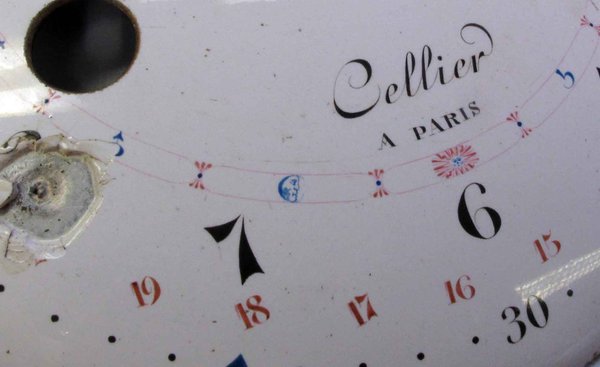
As always, lots to do, lots to see.

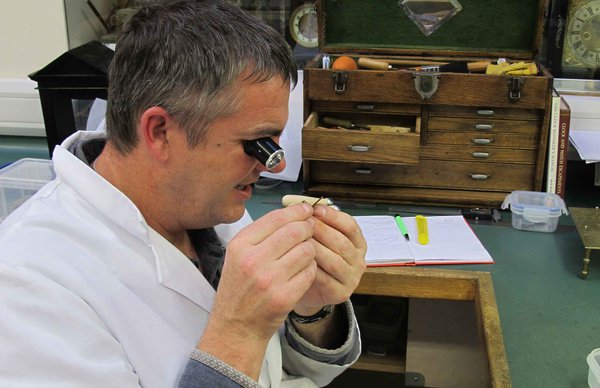
West Dean holds its Open Day on Saturday 10th November 2012. All welcome. See www.westdean.org.uk
Surprising old-timers
This post was written by James Nye
Several of us field enquiries that come from all over the globe, addressed to the secretary at Ticehurst, and which predictably often turn on the issue of ‘How much is my clock worth’, or ‘I found this in the attic. What is it?’
We don’t do the Antiques Roadshow valuation bit – we leave that to our good friends at places like Bonhams and Christies – they know markets.
But if there’s a bit of a challenge in working out who made something, or where, or even why, the AHS team fires up. On the fringes of timekeeping, all sorts of things can crop up, like the ‘pipsqueak’ system in fighter planes, which David covered back in April.
On a theme from my last post (bombing), a colleague and I found ourselves swapping pictures of mine timers recently – mine’s a Mark IV (did you see what I did there?) but his is a splendid Mark I – giving 44 days and 23 hours of delay – all part of the dirty tricks played by both sides in the Second War with secondary and much delayed explosions catching rescue workers.
The movements of these British timers are of the excellent ‘Reform’ type, from Schild, which featured in David Read’s wonderful journal article on the electric remontoire.
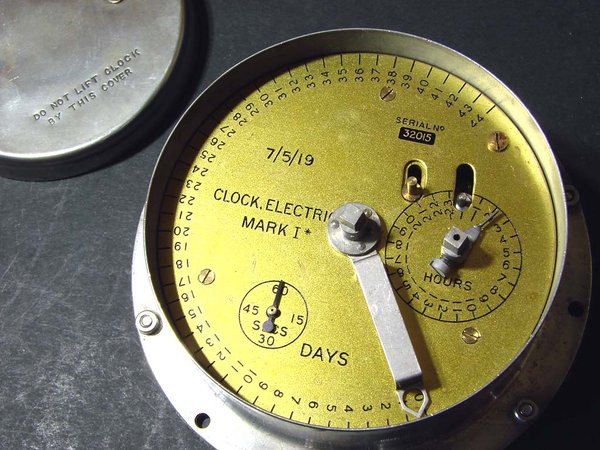
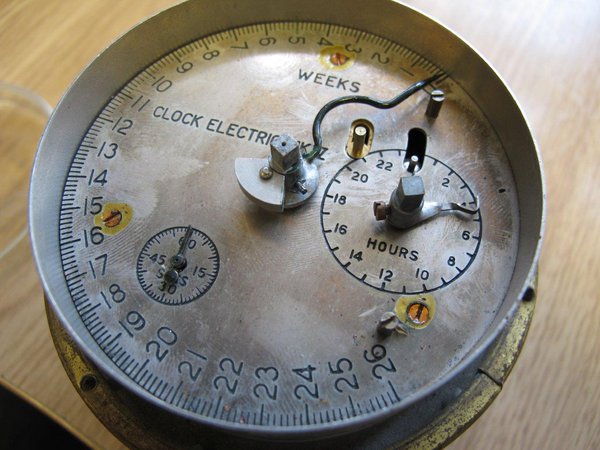
A recent enquiry offered another object lesson in technology linking distant people and allowing the discovery of deeply hidden information. A Ticehurst correspondent (location at first unknown) asked about an electrical clock movement, admitting ‘it is in very bad shape’ and ‘the only name partially visible on the clock is PATENT K. HEIDECG’.
Settling down with a sandwich, and priding myself on an ability to navigate patent databases, I was on the case in seconds, but as I came to the end of my lunch, the crumb-filled keyboard had yielded no answer. Dispirited, I wrote back and asked for pictures.
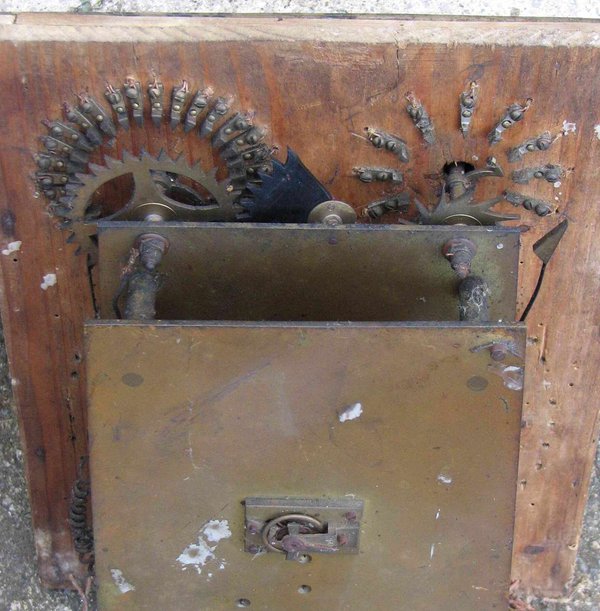
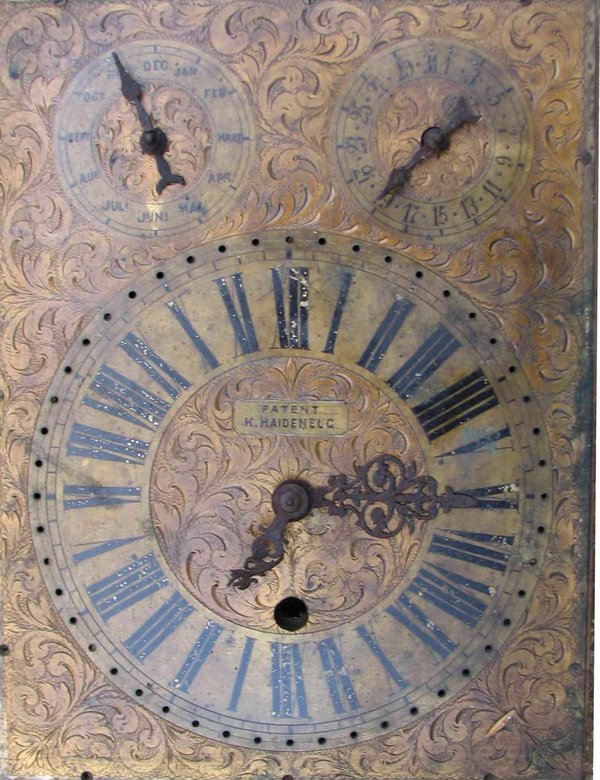
These came, and within moments we had our quarry snared with a one-for-one map to a patent taken out in 1896 by a postmaster – Mr Konstantin Haidenegg – from Pakrac in (what was then) Hungary, for an unusual timer, or signal clock.
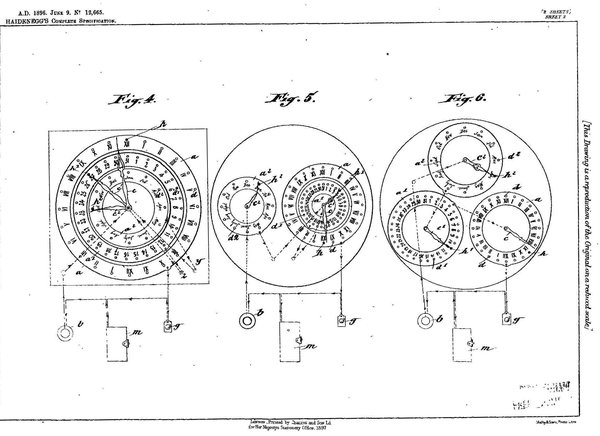
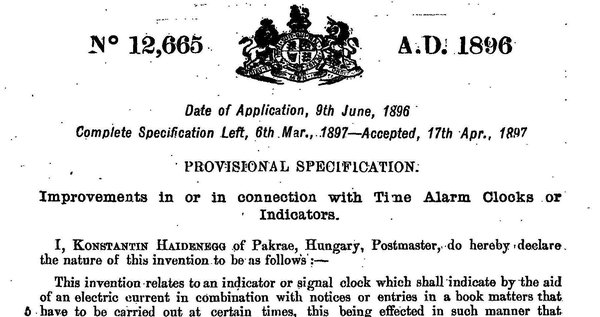
There was a Swiss patent as well, and no doubt a local Hungarian version first of all, but that has not been digitalised yet. However, all this was much to the delight of our correspondent, who lives in – wait for it – Pakrac (now in Croatia)!
No longer Hungary, and no longer hungry, my lunchtime wanderings weren’t wasted and we had another satisfied customer with a local object identified and destined for preservation. Job done!
The worst of times
This post was written by James Nye
I have been musing on the destructive power of war in the lives of various clockmakers and their families.
Consider an obscure Brno clockmaker, Johann Antel (1866–1930). Sporting a boater, his two daughters, Anna and Edith, are ranged left and right – circa 1913. The Antels, from Bohemia, had long German ancestry. In the Great War, Johan lacked vital materials for important commissions. When he died in 1930, the local clockmakers, ethnic Czechs and Germans, all stood for a minute’s silence.
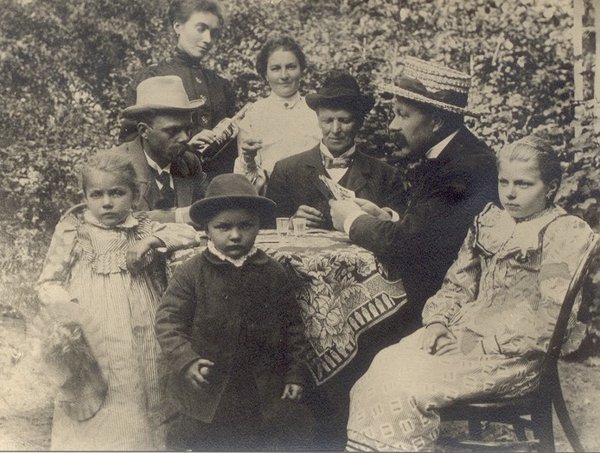
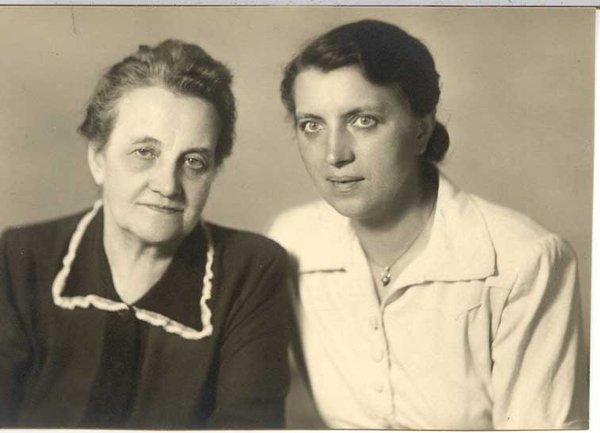
The Nazis arrived in 1938 and it was expedient to prove Germanic ancestry. The archives record the remaining family’s declarations. Daughter Anna had been an apprentice in her dad’s clock shop in Brno, so she was now in charge, along with her mother Ludmilla.
With the arrival of war, nothing was safe – even clock shops were bombed – witness the damage to the Antels’ place.
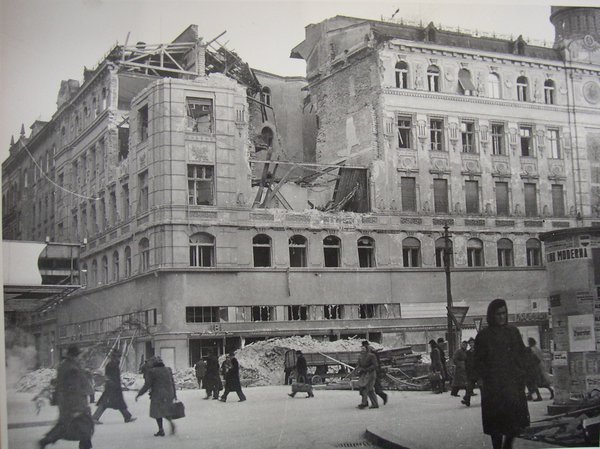
When war ended, the rules changed. Being Czech was suddenly useful and extraordinarily the archives record sister Edith declaring precisely that, and succeeding because she had sheltered a Jewish engineer, Ing. Michaelstadter, whom she duly married.
She stayed in Brno, dying in 1981, while her ‘German’ sister Anna had to flee to Vienna for the rest of her days, dying in 1984.

We only know about Antel because of a 1944 RAF raid on Brno, which set in train a series of events, leading to the station clock emerging in the 1990s.
But war is not a one-way street. What about the Luftwaffe over London? A 1941 raid caused the dramatic collapse of 19–21 Queen Victoria St, taking Standard Time with it.
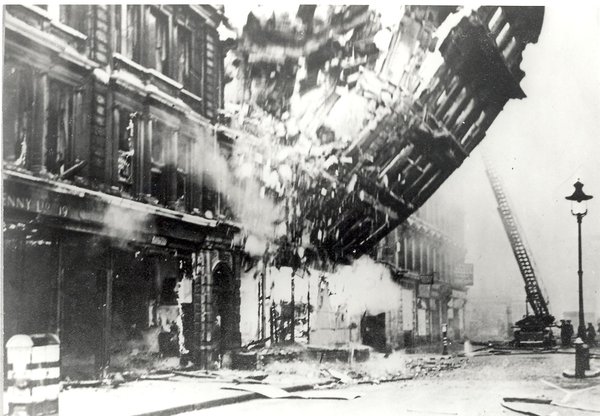

In an archive last week, I realised that exactly the same raid flattened Samuel Smith’s old jewellery shop on Newington Causeway.
John Hoch (1836–1918) worked there for Samuel Smith in the 1870s. Originally from Rheinland-Pfalz, he lived in London, with magnificent sideburns, for the rest of his life. But he was in the wrong place at the wrong time in 1914 and anti-German feeling made life very hard – some of his children even changed their surnames and emigrated.
Hoch didn’t quite make it to the Armistice, dying in the summer of 1918. But you can call on him in Norwood cemetery.
The Silver Swan fictionalized
This post was written by Peter de Clercq
The latest novel by the Australian author Peter Carey, The Chemistry of Tears, was inspired by the Silver Swan of Bowes project.
The Swan is an amazing late 18th-century, life-sized automaton, incorporating three clockwork mechanisms or movements, products of the clockmaking trade. It has been in the Bowes Museum in County Durham, Northeast England, since 1872 where it can be seen in action every afternoon.
In 2008, the Swan underwent a major conservation project, undertaken by our Council member Matthew Read. In 2010 he gave a fascinating talk on the subject for our Society, and recently he went back to Bowes to see that all was well, as reported in his blog ‘Friends Reunited’.
The story in the novel goes back and forth between the 19th century and the present. An Englishman commissions an automaton to be made in Germany. It’s inspired on Vaucanson’s famous digesting duck automaton, but somehow turns out as a (the?) swan – it’s all a bit unclear.
In modern London, a conservator in a fictional museum is given the task of restoring the by now dismantled automaton to working order. Her manager has set her this challenge, hoping it will take her mind off her grief over her lover’s sudden death.
Does it work as a piece of fiction? I am not sure. But what I am sure of is that there cannot be many novels that explicitly mention our journal:
'It was then, high on grief and rage, I stole two of Henry Brandling’s exercise books. What would happen if I was caught? Burn me alive, I didn’t care. I tucked them inside my copy of Antiquarian Horology, and walked straight past Security and out into the London street which was now, in late April, hotter than Bangkok' (p. 34).
If anyone knows another novel in which our journal occurs, please leave a comment!
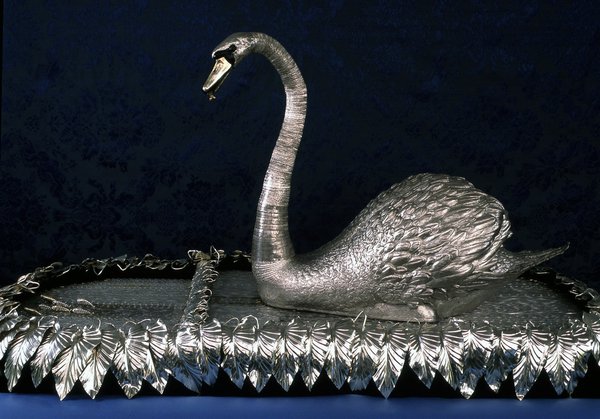
Antiquarian horology in a graveyard
This post was written by David Rooney
Last weekend I went for a walk around King’s Cross and St Pancras, London. The area’s undergoing great change right now as part of a huge regeneration project. I was on the hunt for the mausoleum of one of the world’s greatest antiquarian collectors, Sir John Soane.
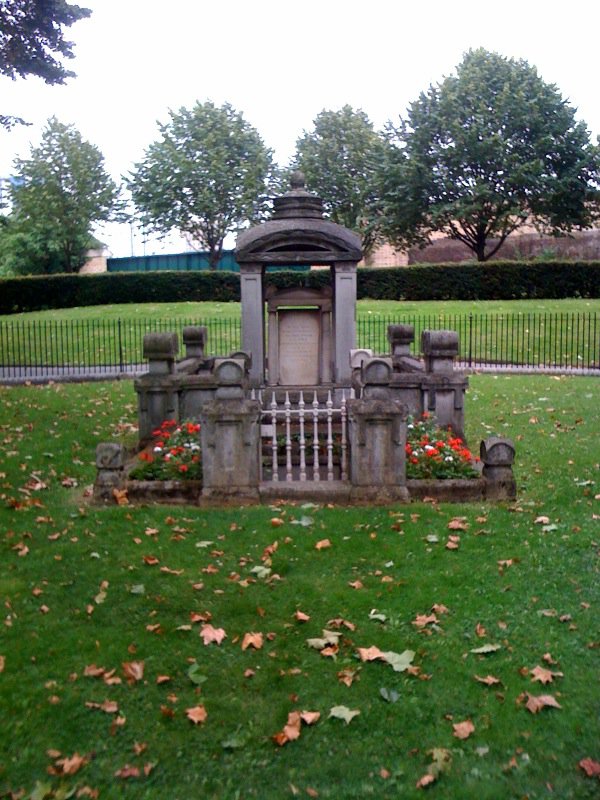
One of my most cherished places is the Soane museum in London, presented to the nation in 1833. Soane’s collection there is quite remarkable.
Sarcophagus in the basement? Check. Hogarths and Turners lining the walls? Check. The most exquisite juxtapositions and delightful sight-lines? Check, check, check. It’s a place like nowhere else. Go often!
My particular reason for viewing Soane’s tomb was that it was used by Sir Giles Gilbert Scott as inspiration for his famous red ‘K2’ telephone kiosk. I like things like that.
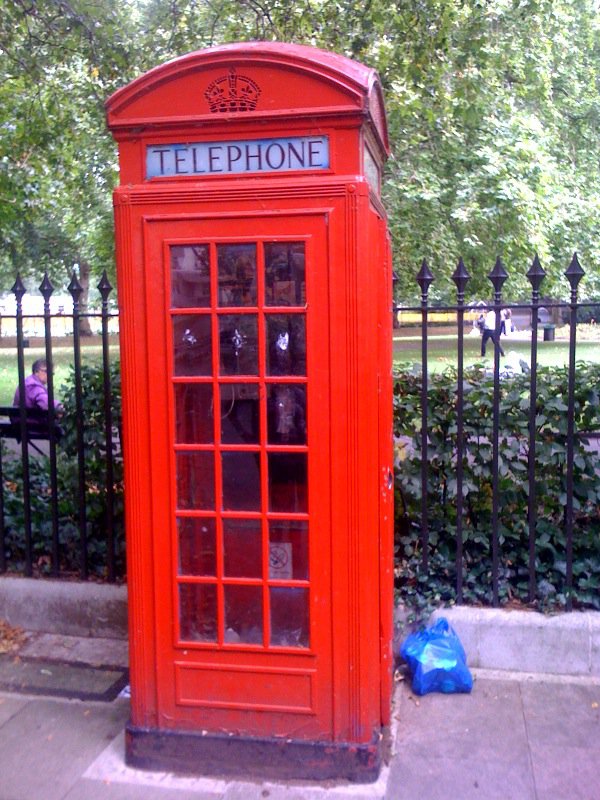
So far, so antiquarian. But where’s the horology? Well, I was on my way out of St Pancras Gardens, where Soane’s memorial sits, when I encountered a memorial sundial erected in 1879 by Baroness Burdett-Coutts, one of the great Victorian philanthropists and an early supporter of the British Horological Institute.
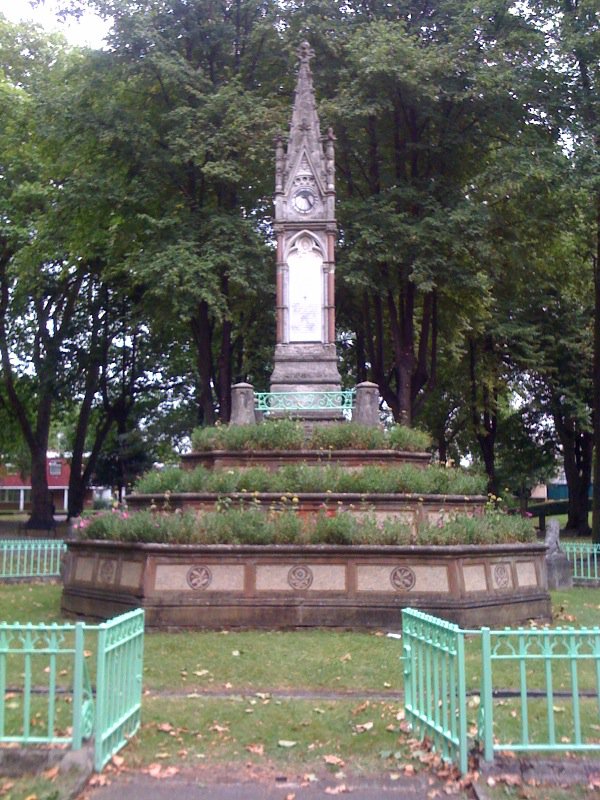
Isn’t it priceless? The sundial is inscribed, ‘tempus edax rerum’, or, ‘time is the devourer of all things’.
I was struck by the calm atmosphere of the gardens set amidst blocks of housing, the railway lines out of St Pancras, a hospital and the general bustle of London. I think the calmness came in part from the embedded memories in the memorials and inscriptions, which were often moving.
Time is the devourer of things. But we have found ways to use things in order to remember. Periodically, they might be reconfigured, as Soane’s tomb became a telephone kiosk. But that’s just our way of killing time.
Lighting up time
This post was written by David Thompson
The story of the night clock, a device which allows the time to be seen in the dark is a long one.
In this modern era of instant electric light, it is easy to forget that in earlier times, getting light at night was quite an involved business. So what better way to solve the problem than to have a clock which was illuminated all through the hours of darkness.
One of the earliest examples of these clocks was that invented by the Campani brothers, Giuseppe, Pietro Tomasso and Matteo Campani from San Felice in Umbria, who worked in Rome in the second half of the 17th century.
However, one clock which caught my attention was a much later, metal cased clock in the form of a Greek urn in which was placed a light source –oil lamp or candle, and which had a system of lenses to project an image of the dial onto a wall in the room.
The clock was made and retailed by the inventor and optical instrument maker Karl August Schmalkalder, born on 29th March 1781, in Stuttgart, Germany. He came to England in about 1800 where he anglicised his name and in later years worked in partnership with his son John Thomas Schmalcalder. On his retirement in 1839 the business was continued by his son.
Charles Augustus married Charlotte Ann Cochran on May 24, 1804, in St Andrews church, Holborn and he died on December 25, 1843 in the Strand Union Workhouse – although he is renowned for his patented prismatic compass, a mechanical drawing device, optical instruments and barometers, sadly his genius did not make him a rich man.
Whilst the Schmalcalder name appears on the clock dial where he describes himself as ‘Patentee’. I have failed to find a patent in that name for this device – it may be that he is simply telling his customers that he is a holder of patents not specifically for this illuminating device.
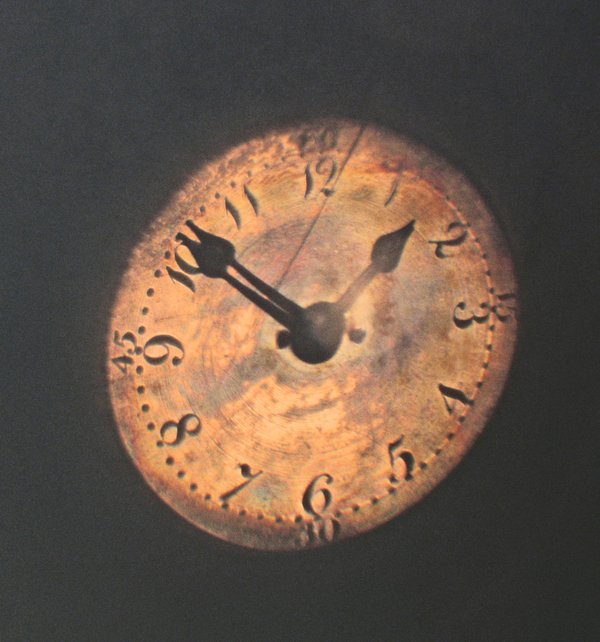
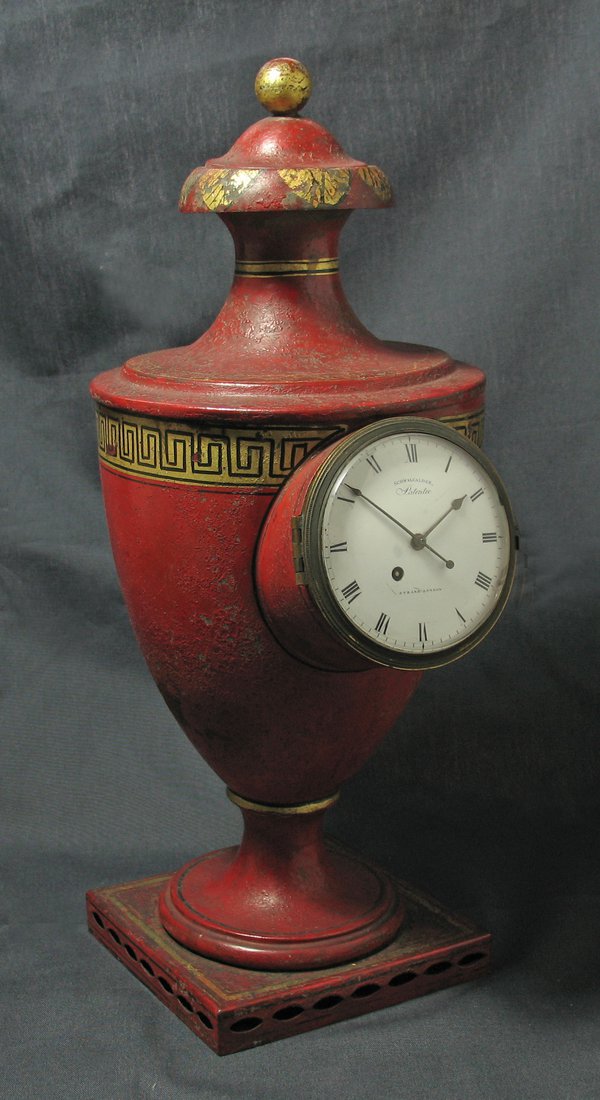
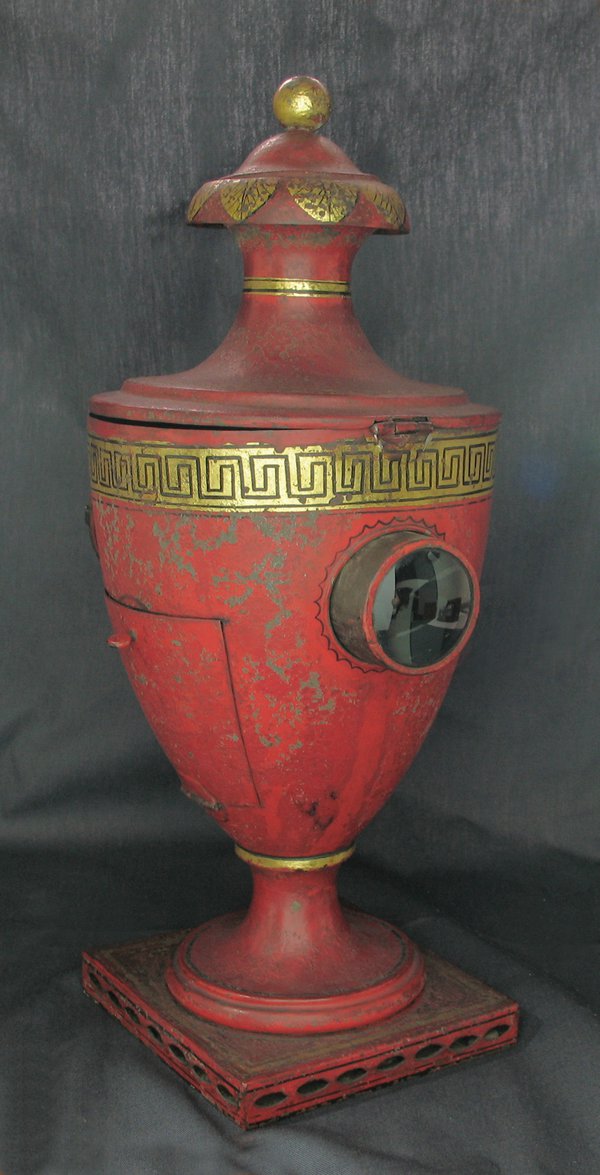
For a detailed account of the Schmalcalders, although without detail of this clock see – Julian Smith, ‘The Schmalcalders of London and the Priddis Dial’, Journal of the Royal Astronomical Society of Canada, Volume 87, No.1, 1993, pp. 4-13.
For more information on the Charles Augustus Schmalcalder, see the family history website created by Steve Smallcalder.
Friends reunited?
This post was written by Matthew Read
Revisiting the Bowes Swan this week – the first time since it was completely disassembled in 2008 – was a personal and surprisingly profound experience.
There is a blogged account of the 2008 conservation project on the web site of the Bowes Museum. That project was at least from my perspective, a commercial professional endeavour, and very hard work!
As the intervening years have passed, some of that professional objectivity has slipped and allowed the Swan and the wonderful Bowes museum to become part of me. Yes, and of course, one can dine out on a project like that for a very long time indeed.
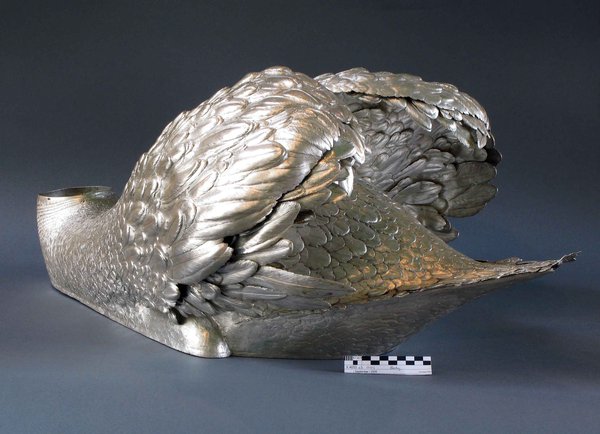

However, snapping back to hard reality, the swan is a bunch of clockwork, levers, cams and ingenuity, and the purpose of this recent visit was to see how everything has stood up to nearly four years of use.
The automaton being played once a day every day the museum is open to the public. Well, of course, as would be expected, it’s a mixed bag. Heavily loaded bearings and working surfaces take the brunt, some mid-twentieth century restorations do not fit quite so comfortably with the eighteenth century, yet overall, the policy of maintenance, observation and importantly, engagement by staff at the museum, seems to be striking that very fine balance between cost (in the widest sense)and benefit.
So the show goes on, the public watch, children stare, almost everyone films and photographs, and often the daily performance receives a round of applause. If you haven’t already, you really should see the sensual and magical swan in action. The Swan is operated daily at 2.00 pm.
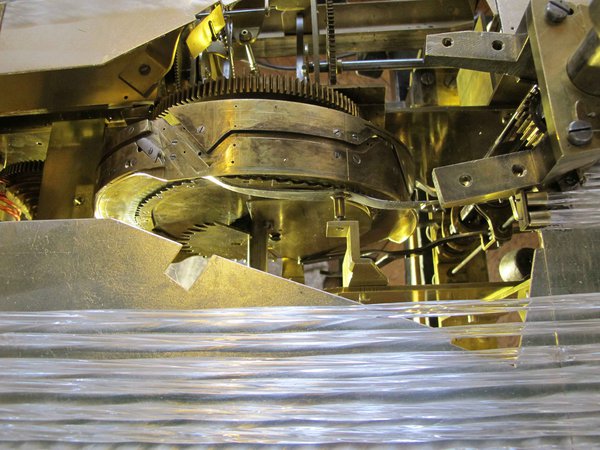
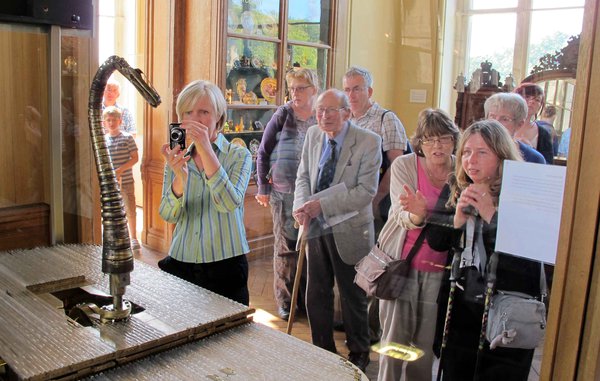
Waking up with a bang
This post was written by Jonathan Betts
In my own time I am Adviser to the National Trust on the care and curatorship of their clocks and watches, and occasionally the Trust’s Advisers on different disciplines are called upon to work together.
Clocks and Firearms might seem an improbable combination, but one object in the Trust’s collections recently brought me and Brian Godwin (Adviser on Firearms) together for a most interesting study day.
Snowshill Manor, a house full of surprises, was, almost inevitably, the source of the object in question – a little gilt-brass table clock with alarm, made about 1740 and signed by Peter Mornier, London. The Trust has any number of clocks with alarm mechanisms, but this particular example has an additional feature, guaranteed to have the owner out of the deepest slumber in a trice.
As with most alarm clocks of the period, the clock sounds a bell at the appointed hour, but then, a flintlock mechanism is triggered and, with a flash and a bang, a lighted candle swings up from a compartment within, jack-in-a-box style, and illuminates the bedside. In fact, if the candle isn’t securely fixed in its swivelling socket inside the clock, there is a distinct possibility it is projected onto the bed itself, guaranteed to have the occupant up and about.
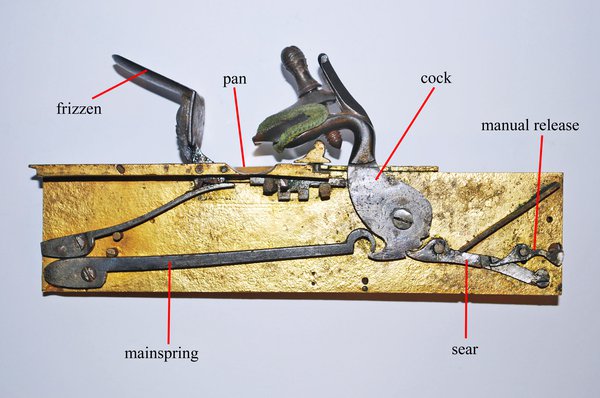

The mission of the two Advisers included a desire to see – and film – the clock working, if at all possible. Needless to say, careful preparation was required to ensure the clock itself was safe and the test was carried out in a brick-lined vault at the back of the Manor, although only a tiny quantity of black powder is needed to fuel the flintlock.
In the event however, not a single ignition took place, as the flintlock’s frizzen (the hardened steel plate against which the flint is supposed to strike the sparks) appeared to be too worn already, and would not oblige. It seems the clock has done its fair share of early morning duties over the years and is entitled to take an extended rest.
A few more experiments will take place to see if we can’t persuade it to perform just once more for the cameras; meanwhile further research on the clock, on Mornier, and on other examples of this kind, is underway and will be written up in Antiquarian Horology in due course.
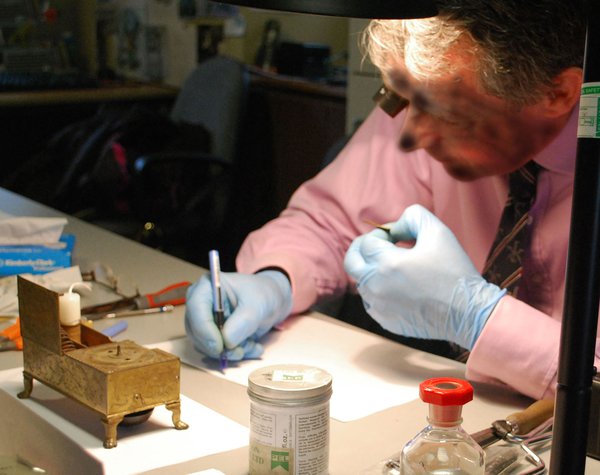
A la recherche du temps synchronisée
This post was written by James Nye
A number of us are fascinated by the whole concept and practice of synchronized public time. As well looking at the time transmission systems installed in London, Paris, Vienna, Berlin and elsewhere in the late nineteenth and early twentieth century, there are other intriguing facets to the world of time, its accuracy and its perception.
On something of an exotic riff, consider time in art. Dalí played with relativity in The Persistence of Memory and its softening watches, whilst Proust’s masterwork meticulously articulates the recovery through memory of a life observed at obsessively close detail – one can feel the clock ticking the author’s life away second by second as the narrative unfolds.
Back to the main hook, and significantly more prosaic, the clock, or broken watch, features regularly in detective fiction – think of Agatha Christie’s Clocks . Alibis often depend on time. I’ve collected detective fiction all my life, and recall the pleasure at finding Lord Peter Wimsey occupied a world full of synchronized clocks.
Witness the following from one of Dorothy L. Sayers’ finest books, Murder Must Advertise:


'The tea-party dwindled to its hour’s end, when Mr Pym, glancing at the Greenwich- controlled electric clock-face on the wall, bustled to the door, casting vague smiles at all and sundry as he went.'
Later in the same book, we learn of Wimsey’s difficulties at remaining in character, in disguise in an advertising agency… 'Nor, when the Greenwich-driven clocks had jerked on to half-past five, had he any world of reality to which to return…'
Sayers again touched on a number of public time themes in a later Wimsey story, Have His Carcase:
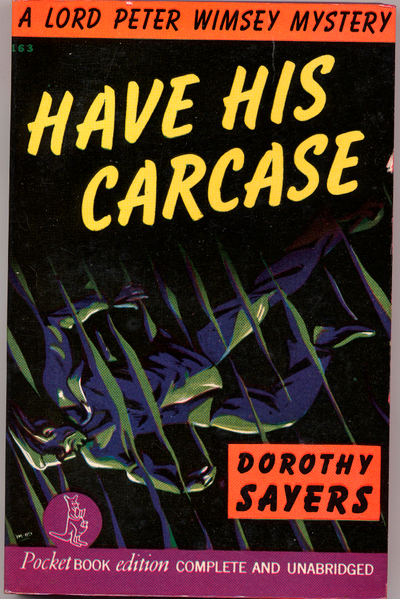
'In that intriguing mystery, the villain was at that moment committing a crime in Edinburgh, while constructing an ingenious alibi involving a steam-yacht, a wireless signal , five clocks and the change from summer to winter time.'
I’ll close with an appeal. If you know of similar appearances of time-signals, synchronized clocks and the like, in plays, novels, whatever, I’d love to hear about them!
A woman horological collector
This post was written by Peter de Clercq
The AHS has recently paid attention to a number of Great Horological Collectors, with lectures that were later reported in the journal. All these lectures were about men.
That a woman could also assemble an important horological collection was demonstrated by the Austrian author Marie von Ebner-Eschenbach (1830-1916). She had received practical training as a watchmaker and brought together a collection of 270 pocket watches dating 16th-19th century.
In 1917 it was purchased for the newly founded Wiener Uhrenmuseum, where the collection (sadly reduced to a mere 47 during World War II) is on display in a special room.
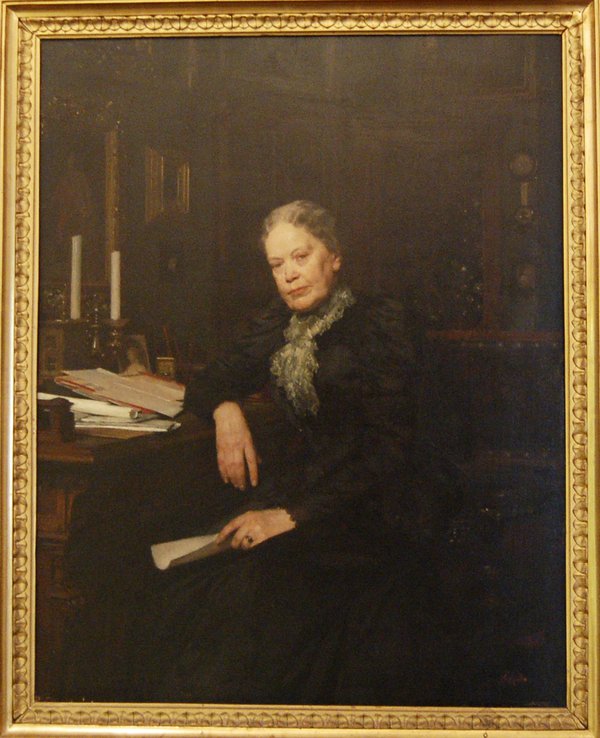
Her horological expertise and her love for her collection are reflected in her short novel Lotti die Uhrmacherin (Charlotte the Woman Watchmaker) of 1889.
Lotti is the daughter of a master watchmaker and is herself skilled in the craft. She inherits her father’s valuable collection of watches and refuses offers from other collectors, until her former fiancé gets in financial trouble. She relents and sells the collection, to be able to support him (anonymously).
Chapter 3 describes the collection in remarkable technical and historical detail, and names many makers – Le Roy, Breguet, Tompion and Mudge, to mention just a few.
Further reading: Eva-Maria Orosz, ‘“My watches make it hard for me to die”. Marie von Ebner-Eschenbach: the writer as watch collector’, pages 10-13 in Highlights from the Vienna Museum of Clocks and Watches (Vienna, 2011); I thank Fortunat Mueller-Maerki for bringing this essay to my attention. There is no English translation of Lotti die Uhrmacherin , but a freely downloadable edition with some English annotation is on-line here.
A multiplicity of times
This post was written by David Rooney
David Thompson’s post about Metamec ‘time savings’ clocks excited me, because I am interested in the wider cultural meanings around seemingly innocuous phrases such as ‘time is money’.
A few years ago, I wrote an article on the subject for the Science Museum’s ‘Ingenious’ website. It looked at the history of Benjamin Franklin’s 1748 phrase and how its meanings in different times and places varied.
Reading the article back, I have been reminded of a fascinating book by anthropologist Kevin Birth called Any Time is Trinidad Time (University Press of Florida, 1999).
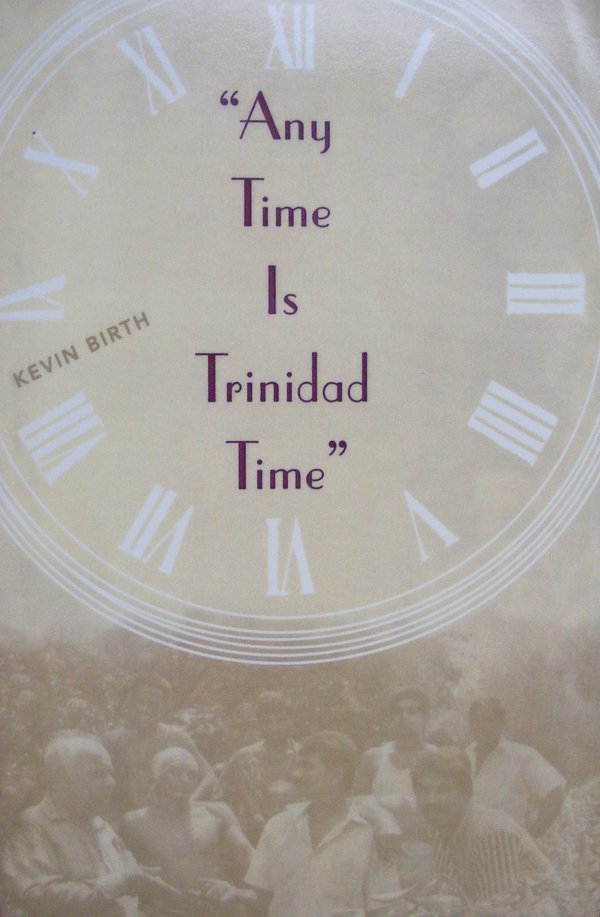
Here’s what I wrote for the Science Museum:
'Trinidad, a Caribbean island between Venezuela and the USA, has a rich history of settlement and immigration. It is ethnically and culturally highly diverse, with residents of mainly Black and Indian origin mixing with Spanish, French and English colonial culture.
'Social anthropologist Kevin Birth spent time living there in 1989 in order to study cultures of timekeeping. Starting out with the often-used phrase "any time is Trinidad time", originally attributed to calypso singer Lord Kitchener, Birth explored the ways people come together with differing notions of timekeeping, and how conflicts are managed.
'He also looked at phrases like "time is money", "time management" and "budgeting time" and found that their use and meaning is highly complex and culture-specific. Generalisations were impossible.
'We all carry around with us a great variety of "personal times" – value systems linking time with activity – and we deploy them in highly complex ways according to culture, context and circumstances. Phrases like the Lord Kitchener lyric are complex devices used to oil the wheels of societies under time pressure.'
If you’re interested in how different societies use clocks, I can heartily recommend reading Birth’s book.
Money saving time
This post was written by David Thompson
There would be a knock at the door and my mother was busy. She would say 'that will be the insurance man – answer the door and give him this money and tell him the number is 16251'.
Many of us remember these numbers rather in the same way that anyone who did national service or served in the regular armed forces will surely remember their ID number.
In 1954 the Time Savings Clock Company Limited and Metamec of Dereham applied for a patent for a clock which would only go when coins were placed in a slot in the top of the case. Two florins weekly it says on the coin slot in the case top.
For people on insurance schemes with companies like the Co-operative in the 1950s, four shillings was quite a lot on money to put aside each week. The idea of the clock was to help people hold on to their money to pay the premium each week.
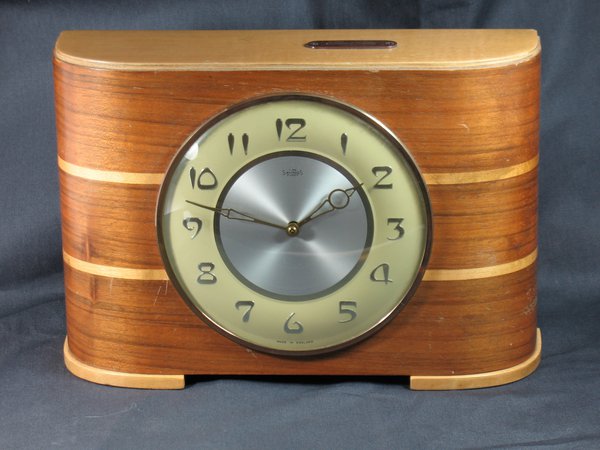

The system was invented by William Arthur Pitt and the patent was granted to the Time Savings Clock Company of Manchester (no.772,762). The mechanism consisted of a series of levers and wheels which arrested the going of the clock to which it was fitted until coins were inserted to release it and thus allow the clock to run.
These coins, after operating the levers would fall into the space at the bottom of the clock case, covered by a wooden panel which fitted over a stud and was closed by a wire and lead seal applied by the insurance man. When he called he would cut the seal, empty out the money and re-seal the back until his next visit – simple.

A full account of these clocks and many more everyday clocks can be found in Clifford Bird’s book – Metamec Clock Maker Dereham published in 2003 by the Antiquarian Horological Society.